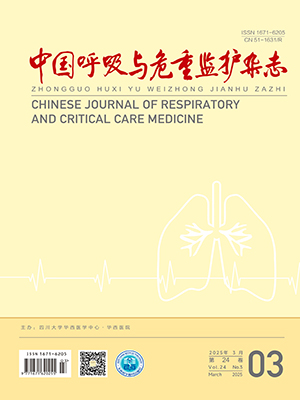| 1. |
中华医学会呼吸病学分会哮喘学组, 中国哮喘联盟. 重症哮喘诊断与处理中国专家共识. 中华结核和呼吸杂志, 2017, 40(11): 813-829.
|
| 2. |
Côté A, Godbout K, Boulet LP. The management of severe asthma in 2020. Biochem Pharmacol, 2020, 179: 114112.
|
| 3. |
Reihman AE, Holguin F, Sharma S. Management of severe asthma beyond the guidelines. Curr Allergy Asthma Rep, 2020, 20(9): 47.
|
| 4. |
Chung KF, Wenzel SE, Brozek JL, et al. International ERS/ATS Guidelines on Definition, Evaluation and Treatment of Severe Asthma. Eur Respir J, 2014, 43: 343-373.
|
| 5. |
Shaw DE, Sousa AR, Fowler SJ, et al. Clinical and inflammatory characteristics of the European U-BIOPRED adult severe asthma cohort. Eur Respir J, 2015, 46(5): 1308-1321.
|
| 6. |
Kim MH, Kim SH, Park SY, et al. Characteristics of adult severe refractory asthma in Korea analyzed from the Severe Asthma Registry. Allergy Asthma Immunol Res, 2019, 11(1): 43-54.
|
| 7. |
van Bragt JJMH, Adcock IM, Bel EHD, et al. Characteristics and treatment regimens across ERS SHARP severe asthma registries. Eur Respir J, 2020, 55(1): 1901163.
|
| 8. |
中华医学会呼吸病学分会哮喘学组. 支气管哮喘防治指南(2020年版). 中华结核和呼吸杂志, 2020, 43(12): 1023-1048.
|
| 9. |
中华医学会变态反应分会呼吸过敏学组, 中华医学会呼吸病学分会哮喘学组. 中国过敏性哮喘诊治指南(第一版, 2019年). 中华内科杂志, 2019, 58(9): 636-655.
|
| 10. |
Simpson JL, Phipps S, Baines KJ, et al. Elevated expression of the NLRP3 inflammasome in neutrophilic asthma. Eur Respir J, 2014, 43(4): 1067-1076.
|
| 11. |
Reddel HK, Taylor DR, Bateman ED, et al. An official American Thoracic Society/European Respiratory Society statement: asthma control and exacerbations: standardizing endpoints for clinical asthma trials and clinical practice. Am J Respir Crit Care Med, 2009, 180(1): 59-99.
|
| 12. |
中华医学会, 中华医学会杂志社, 中华医学会全科医学分会, 等. 常规肺功能检查基层指南(2018年). 中华全科医师杂志, 2019, 18(6): 511-518.
|
| 13. |
王茹. 家庭收入、生活方式对中国成人肥胖的影响. 东南大学, 2020.
|
| 14. |
中华医学会呼吸病学分会肺功能专业组. 肺功能检查指南(第二部分)——肺量计检查. 中华结核和呼吸杂志, 2014, 37(7): 481-486.
|
| 15. |
中华医学会呼吸病学分会哮喘学组. 咳嗽的诊断与治疗指南(2021). 中华结核和呼吸杂志, 2022, 45(1): 13-46.
|
| 16. |
Dweik RA, Boggs PB, Erzurum SC, et al. An official ATS clinical practice guideline: interpretation of exhaled nitric oxide levels (FENO) for clinical applications. Am J Respir Crit Care Med, 2011, 184(5): 602-615.
|
| 17. |
胡群, 吴雯雯, 姬郁林, 等. 多维度评估识别重症支气管哮喘的可治疗特质. 中国呼吸与危重监护杂志, 2021, 20(4): 282-288.
|
| 18. |
王文雅, 林江涛, 周新, 等. 我国>14岁重症哮喘患者的临床特征和患病危险因素. 中华医学杂志, 2020, 100(14): 1106-1111.
|
| 19. |
Wang WJ, Wang JH, Song GH, et al. Environmental and sensitization variations among asthma and/or rhinitis patients between 2008 and 2018 in China. Clin Transl Allergy, 2022, 12(2): e12116.
|
| 20. |
Abdo M, Trinkmann F, Kirsten AM, et al. Small airway dysfunction links asthma severity with physical activity and symptom control. J Allergy Clin Immunol Pract, 2021, 9(9): 3359-3368.
|
| 21. |
Bahmer T, Waschki B, Schatz F, et al. Physical activity, airway resistance and small airway dysfunction in severe asthma. Eur Respir J, 2017, 49(1): 1601827.
|
| 22. |
McBrien CN, Menzies-Gow A. The biology of eosinophils and their role in asthma. Front Med (Lausanne), 2017, 4: 93.
|
| 23. |
姚庆美, 陈玥, 黎友伦, 等. 重症哮喘气道上皮细胞损伤机制及潜在生物治疗靶点. 中国呼吸与危重监护杂志, 2022, 21(12): 899-903.
|
| 24. |
Schleich F, Graff S, Guissard F, et al. Asthma in elderly is characterized by increased sputum neutrophils, lower airway caliber variability and air trapping. Respir Res, 2021, 22(1): 15.
|
| 25. |
程丽, 蒋毅, 岳倩如, 等. 呼出气一氧化氮和外周血嗜酸粒细胞计数对嗜酸粒细胞型哮喘的诊断价值. 中华全科医师杂志, 2020, 19(6): 502-506.
|
| 26. |
Merianos AL, Jandarov RA, Cataletto M, et al. Tobacco smoke exposure and fractional exhaled nitric oxide levels among U. S. adolescents. Nitric Oxide, 2021, 117: 53-59.
|
| 27. |
Porsbjerg C, Menzies-Gow A. Co-morbidities in severe asthma: clinical impact and management. Respirology, 2017, 22(4): 651-661.
|
| 28. |
Bruno A, Pace E, Cibella F, et al. Body mass index and comorbidities in adult severe asthmatics. Biomed Res Int, 2014, 2014: 607192.
|




